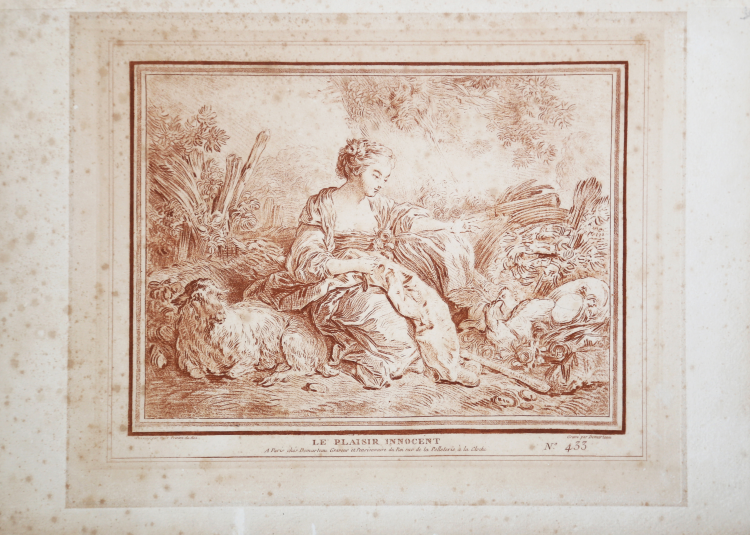



| Reference: | S5267 |
| Author | Gilles DEMARTEAU |
| Year: | 1760 ca. |
| Measures: | 300 x 240 mm |


| Reference: | S5267 |
| Author | Gilles DEMARTEAU |
| Year: | 1760 ca. |
| Measures: | 300 x 240 mm |
Crayon manner, printed in red, signed at lower right.
After a drawing by Paul Huet.
A fine impression, printed on contemporary laid paper, with margins, some foxing, otherwise good condition.
Numbered on plate; lettered with names of producers, publication address: 'A Paris chés Demarteau (...) rue de la Pelterie a la Cloche', and detail on the original's provenance.
Plate 433 in the catalogue published by Demarteau's nephew in 1788.
He numbered his plates from 1-560, and these numbers are followed in Leymarie's catalogue. Numbers 561 onwards are the work of his nephew and successor Gilles Antoine. There is in the BN a 1788 catalogue/price list that gives the subjects of numbers up to 664; so numbers from 665 onwards are later than the catalogue.
|
L de Leymarie, 'L'Oeuvre de GD', 433; IFF 433.
|
Gilles DEMARTEAU (Liegi 1729 - Parigi 1776)
|
French engraver and print publisher. He was descended from a family of gunsmiths. In 1739 he went to Paris to join a brother who had established himself there as a goldsmith. Beginning as an engraver and chaser, in 1746 he obtained the rank of master. As early as 1757 he began to specialize in crayon manner using a roulette, a process that brought him success; Jean-Charles François contributed in developing this process, but Demarteau, because of his superior skill, outstripped his rival. At a time when drawing was greatly in vogue, he offered the public faithful reproductions, first of red chalk drawings and then of drawings intended for decoration or teaching, in two or three colours, by contemporary artists. His oeuvre comprises 560 numbered plates, half of them after specially provided drawings by François Boucher or after drawings owned by collectors such as Blondel d’Azincourt. Demarteau also engraved some 40 drawing manuals, consisting of collections of plates after Edme Bouchardon, Jean-Pierre-Louis-Laurent Hoüel and Jean-Baptiste Huet I. He was a protégé of Charles-Nicolas Cochin (II) and was praised by Denis Diderot; in 1769 he was admitted to the Académie Royale with his engraving after Cochin of Lycurgus Wounded. In 1770 he succeeded François as Graveur des Dessins du Cabinet du Roi.
|
|
L de Leymarie, 'L'Oeuvre de GD', 433; IFF 433.
|
Gilles DEMARTEAU (Liegi 1729 - Parigi 1776)
|
French engraver and print publisher. He was descended from a family of gunsmiths. In 1739 he went to Paris to join a brother who had established himself there as a goldsmith. Beginning as an engraver and chaser, in 1746 he obtained the rank of master. As early as 1757 he began to specialize in crayon manner using a roulette, a process that brought him success; Jean-Charles François contributed in developing this process, but Demarteau, because of his superior skill, outstripped his rival. At a time when drawing was greatly in vogue, he offered the public faithful reproductions, first of red chalk drawings and then of drawings intended for decoration or teaching, in two or three colours, by contemporary artists. His oeuvre comprises 560 numbered plates, half of them after specially provided drawings by François Boucher or after drawings owned by collectors such as Blondel d’Azincourt. Demarteau also engraved some 40 drawing manuals, consisting of collections of plates after Edme Bouchardon, Jean-Pierre-Louis-Laurent Hoüel and Jean-Baptiste Huet I. He was a protégé of Charles-Nicolas Cochin (II) and was praised by Denis Diderot; in 1769 he was admitted to the Académie Royale with his engraving after Cochin of Lycurgus Wounded. In 1770 he succeeded François as Graveur des Dessins du Cabinet du Roi.
|